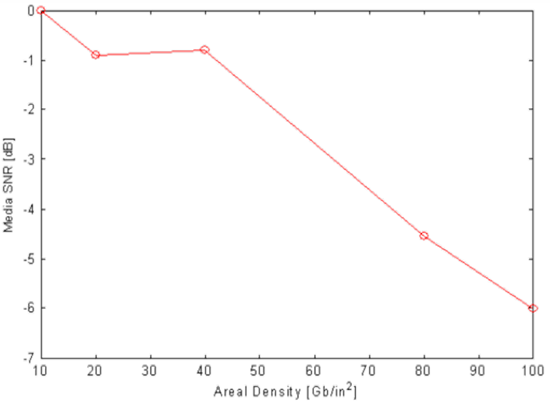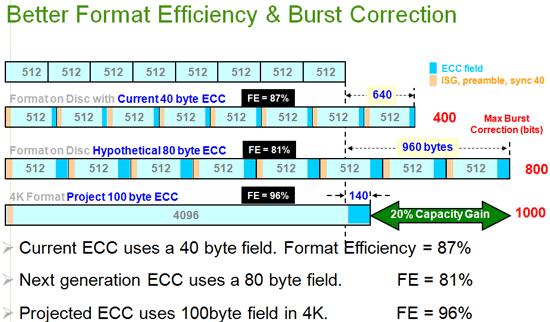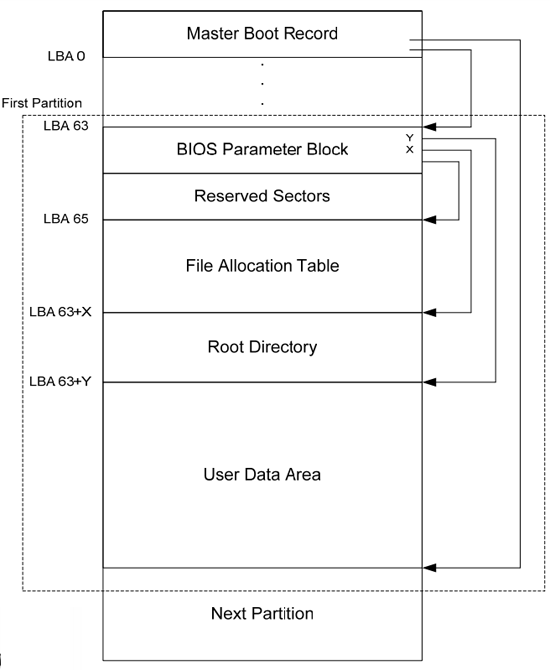Western Digital’s Advanced Format: The 4K Sector Transition Begins
by Ryan Smith on December 18, 2009 12:00 AM EST- Posted in
- Storage
We had a chance to talk to Western Digital last week about a new hard drive technology they have coming down the pipe called Advanced Format. Ahead of the impending launch of the first Advanced Format drives, Western Digital is engaging in an education campaign about the technology, as it represents the first step in a general transition for hard drives, and is a transition that can’t be done completely behind the scenes. Specifically, Advanced Format is going to bring about some issues where older operating systems (and we’re looking almost exclusively at Windows XP here) will inadvertently harm drive performance by making certain assumptions about the drives that will no longer be true.
We’ll get in to the nitty-gritty about the impact of this in a bit, but first let’s start with Advanced Format. What is it? In a nutshell, it’s replacing the traditional 512 byte hard drive sector with a 4 kilobyte (4,096B) hard drive sector for a number of practical and technological reasons. Advanced Format is the name Western Digital is giving to drives implementing 4KB sectors.
The move to 4K-sectors has been some 10 years in the making, as research in the late 90’s identified that 512B sectors made less and less sense as drives continued to get larger. At a time when hard drives were measured in megabytes, 512B sectors were a good balance between technical factors and a desire to keep wasted space at a minimum (you can’t normally put 2 files in 1 sector), but times have changed and hard drive capacities are several orders of magnitude larger.
The crux of the problem is that there are 3 factors that are in constant need of balancing when it comes to hard drive design: areal density, the signal-to-noise ratio (SNR) in reading from drive platters, and the use of Error Correcting Code (ECC) to find and correct any errors that occur. As areal density is increases, sectors become smaller and their SNR decreases. To compensate for that, improvements are made to ECC (usually through the use of more bits) in order to maintain reliability. So for a drive maker to add more space, they ultimately need to improve their error-correction capabilities, which means the necessary ECC data requires more space. Rinse, wash, repeat.

The SNR for various areal densities
At some point during this process drive manufacturers stop gaining any usable space - that is, they have to add as much ECC data as they get out of the increase areal density in the first place - which limits their ability to develop larger drives. Drive manufacturers dislike this both because it hinders their ability to develop new drives, and because it means their overall format efficiency (the amount of space on a platter actually used to store user data) drops. Drive manufacturers want to build bigger drives, and they want to spend as little space on overhead as possible.
But all is not lost. The principle problem here is that ECC correction takes place in 512B chunks, while ECC can be more efficient when used over larger chunks of data. If ECC data is calculated against a larger sector, even though more ECC data is necessary than for a single 512B sector, less ECC data than the sum of multiple sectors is needed to maintain the same level of operational reliability. One estimate for 4K sector technology puts this at 100 bytes of ECC data needed for a 4K sector, versus 320 (40x8) for 8 512B sectors. Furthermore the larger sectors means that larger erroneous chunks of data can be corrected (burst error correction), something that was becoming harder as greater areal densities made it easier to wipe out larger parts of a 512B sector. As a result, the need for the larger sector is born.

As for why Western Digital and other drive makers are transitioning specifically to a 4K sector, the rationale is based on the earlier problems. 4K sectors are much larger than 512B sectors, which means they benefit more from our earlier ECC optimizations, which in turn brings a greater increase in format efficiency than using smaller sectors (i.e. 1K).
4K also happens to be a magical number elsewhere when it comes to computers – this is primarily rooted in the fact that a normal page of memory on an x86 processor continues to be 4KB (ed: 4MB pages also exist). The x86 page size in turn has also lead to file system clusters (the smallest unit of storage in a file system) becoming 4KB as 4KB clusters neatly fit in to a page of memory, while the need for smaller clusters has subsided amidst a general increase in file size (i.e. fewer files are smaller than 4KB and waste space). NTFS, EXT3, and HFS+ all default to 4KB clusters on modern hard drives. So 4KB physical sectors map perfectly with 4KB file system clusters, which in turn map perfectly with 4KB memory pages. And hence 4KB is the largest practical size for a hard drive sector at this time.
| Old Sector | New Sector | x86 Mem Page | NTFS Cluster | HFS+ Cluster | |
| Size | 512B | 4K | 4K | 4K | 4K |
So what’s the net benefit from all of this for consumers? At the moment, not a lot, which is why this is a low-key launch for Western Digital, and the focus of this is an education effort on what the use of 4K sectors means for older operating systems. The biggest benefit is going to be that this will enable Western Digital to more easily design drives over 2TB in size.
From a numbers perspective, Western Digital estimates that the use of 4K sectors will give them an immediate 7%-11% increase in format efficiency. ECC burst error correction stands to improve by 50%, and the overall error rate capability improves by 2 orders of magnitude. In theory these reliability benefits should immediately apply to all 4K sector drives (making the Advanced Format drives more reliable than regular drives), but Western Digital is not pushing that idea at this time.

IDEMA projected format efficiency and ECC burst sizes
With all of that said, to make this kind of advancement practical, a transition period is necessary. That transition period will be done through the use of 512B emulation technology, which will expose Advanced Format drives to the drive controller and operating system as having 512B sectors, when in reality they will have 4K sectors. Unfortunately, this method has a downside, which is the ultimate reason for Western Digital’s education campaign.

512 byte sector emulation: how the drive is laid out (physical) and what the OS sees (logical)
With the emulation of 512B sectors, there’s the risk that a partition could be misaligned compared to the 4K physical sectors - where it would be unwittingly started in the middle of such a sector. As a result, the clusters of a file system on that partition would end up straddling 4K sectors, which would cause performance problems. Specifically, in testing IDEMA (the drive manufacturers’ trade group) found that random writes in would be particularly impacted, as a Read-Modify-Write(RMW) would need to take place to update each sector, rather than a straight write(ed: This is very similar to writing to a dirty block on a SSD). Although this isn’t mechanically/electronically harmful in any way, the performance hit compared to a straight write makes it undesirable.

A single unaligned 4K cluster straddling 2 physical sectors

A misaligned partition under WinXP. Only LBAs divisible by 8 are aligned










86 Comments
View All Comments
mcnabney - Monday, December 21, 2009 - link
My concern is that WHS is kind of designed to last a long time. I don't know what a new build of WHS based upon Server08 is going to offer the consumer. I really envisioned my server staying as it is for a long time, only occasionally adding a drive to the pool as needed. I have a 14-bay case, plus the ability to add external racks, so I have a lot of potential growth. I would prefer not having a headache in 2011 when these drives are the standard. I also don't see the need to upgrade/replace my server until the hardware dies. It isn't like an OS that you use every day that can always use a revision.DanNeely - Friday, December 18, 2009 - link
Also. Has MS released any major core OS updates to WHS since the rest of windows 5.x went onto extended support? Patches to things that are WHS specific don't count. I'm asking about features that are/should be common with XP/2k3.DanNeely - Friday, December 18, 2009 - link
I wouldn't hold my breath. The HW companies have work around's available even if they're suboptimal; and WHS has a fairly small userbase to justify a major engineering effort. Especially since a new version of WHS based on server 08 is rumored to be coming next year and patching the current WHS would only draw attention to not patching XP/server 2k3.azmodean - Friday, December 18, 2009 - link
Yes, there would be HUGE issues throughout the file system stack, and also bleeding over into page table management, memory management, DMA, drivers, and who knows what else. It's not a simple fix at all, and even if they weren't halting support for winXP, I doubt they'd be willing to make the necessary changes.Linux went through this process a while back, and it was a very extensive set of changes even though Linux was more modular than windows to start with.
mczak - Friday, December 18, 2009 - link
We're not talking about making XP 4K blocks aware, but simply let it create partitions aligned on 4K boundaries. This would be a trivial fix. But yes it's not a security issue so no luck.btw I wonder what the performance is like if partition is unaligned. Noone tested?
ppelleg - Sunday, February 21, 2010 - link
Yes... and it was terrible!!!After aligning the stuff using WD Align (the WD utility) the problem was solved and I get back performances...
evalfi - Monday, April 12, 2010 - link
I installed XP SP3 on an older master drive (40GB)Then from XP I choose to format the WD10EARS slave drive in logical sectors of 4K.
Will it still be necessary to run the alignment tool on this Drive?
Greetz & Thanks
ken1945 - Saturday, April 17, 2010 - link
Does anyone know if WD 4K drives that were originally formatted on a Mac using OSX, will have any alignment problems when running XP on that Mac under Bootcamp, VM Fusion, Parallels, etc?FYI, I remember back in the late 1970s when Wang transitioned from 256B sectors to 1K blocks when their hard drive storage cabinets (the size of a small desk!) increased to 80MB. No transition problems except for hernias.
MrCyberdude - Tuesday, May 11, 2010 - link
What a nightmare these WD20EARS drives have given me with the 4k cluster overlap.The ReadyNas Pro speed is down to 1/5th the speed of 22MB/sec write. when tested with Bonnie++ and actual file copies.
A complete joke that WD states that it does not support Linux.
A complete Joke that Netgear has not tested these drives and got them working with their product as they are a Major HDD supplier.
http://www.readynas.com/forum/viewtopic.php?f=24&a...
MrCyberdude
mfreesto - Sunday, September 12, 2010 - link
So how will 4K affect RAID set ups? I setup several WD 20EARS drives in RAID 5, and of course Win7 only sees one' drive'. Has the RAID controller correctly aligned the drive?The WD Align tool is no use as it sees the RAID array as a non-WD drive.
This is using the built in nVidia RAID on an Asus M3N78-EM. nVidia is silent on the issue, and the WD website doesn't discuss RAID in the context of AFT.
Anyone got any insights?